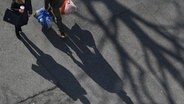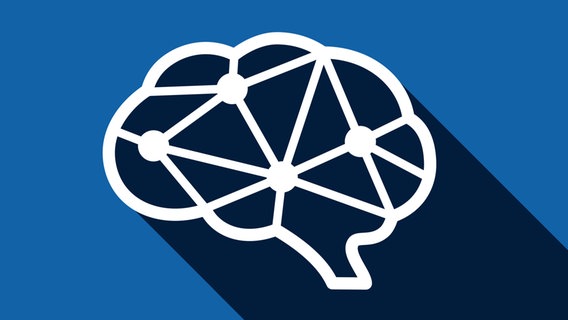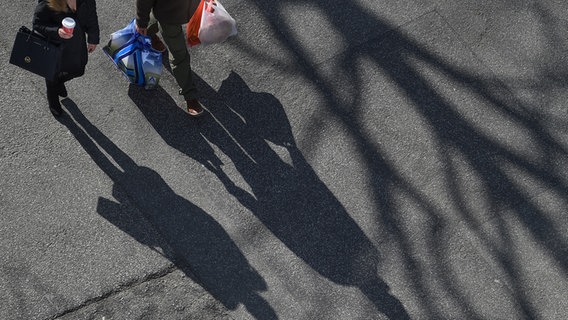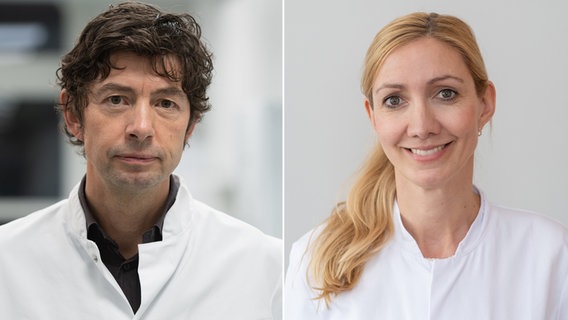(3) Woher stammt das Coronavirus?
Host Maja Bahtijarević geht im Gespräch mit NDR Wissenschaftsjournalist Wieland Gabcke der Frage nach, wo der Ursprung des neuartigen Coronavirus sein könnte - ist es wirklich von Fledermäusen auf den Menschen übergesprungen oder wurde es doch aus einem Virologielabor in die Welt rausgetragen?
Die Quellen:
Menachery, Vineet (u.a.), "A SARS-like cluster of circulating bat coronaviruses shows potential for human emergence", Nature Medicine, 9.11.2015: https://www.nature.com/articles/nm.3985
Das S4-Labor im Robert-Koch-Institut: https://www.rki.de/DE/Content/Infekt/Diagnostik_Speziallabore/Hochsicherheitslabor/Hochsicherheitslabor.html
Das S3-Labor in Helmholtzzentrum für Infektionsforschung: https://www.helmholtz-hzi.de/de/forschung/technologieplattformen/uebersicht/s3-labor/unser-labor/
Silver, Andrew (u.a.), "China will Virenforscher stärker kontrollieren", Spektrum der Wissenschaft, 21.4.2020: https://www.spektrum.de/news/china-will-virusforscher-staerker-kontrollieren/1725534
Deuber, Leo, "Chronik der verlorenen Zeit", in: Süddeutsche Zeitung, 4.4.2020: https://projekte.sueddeutsche.de/artikel/politik/coronavirus-in-wuhan-chronik-der-vertuschung-e418140/?reduced=true
Botao, Xiao (u.a.), "The possible origin of the 2019-nCoV coronavirus", ResearchGate, Februar 2020: https://web.archive.org/web/20200214144447/https://www.researchgate.net/publication/339070128_The_possible_origins_of_2019-nCoV_coronavirus und https://img-prod.tgcom24.mediaset.it/images/2020/02/16/114720192-5eb8307f-017c-4075-a697-348628da0204.pdf
"Immer lautere Forderungen an China", Tagesschau.de, 19.4.2020: https://www.tagesschau.de/inland/china-corona-117.html
Zhengli, Shi (u.a.), "Origin and evolution of pathogenic coronaviruses", Nature Reviews Microbiology, 10.12.2018: https://www.nature.com/articles/s41579-018-0118-9
Qui, Jane, "How China’s ‚bat woman‘ hunted down viruses from SARS the the New Coronavirus", Scientific American, 11.3.2020, aktualisiert für Juni 2020: https://www.scientificamerican.com/article/how-chinas-bat-woman-hunted-down-viruses-from-sars-to-the-new-coronavirus1/
Bengston, Dean, "All journal articles evaluating the origin or epidemiology of SARS- CoV-2 that utilize the RaTG13 bat strain genomics are potentially flawed and should be retracted", OSFpreprints, 21.4.2020: https://osf.io/wy89d/
Peter Dasnak über RaTG13-Diskussion auf Twitter: https://twitter.com/PeterDaszak/status/1259111768217063424
Segreto, Rossana, "Is considering a genetic-manipulation origin for SARS-CoV-2 a conspiracy theory that must be censored?", ResearchGate, April 2020: https://www.researchgate.net/publication/340924249_Is_considering_a_genetic-manipulation_origin_for_SARS-CoV-2_a_conspiracy_theory_that_must_be_censored
Anonymer Autor, "The undeniable evidence that the Wuhan-Coronavirus is man- made", NerdHasPower-Blog, März 2020: https://nerdhaspower.weebly.com/ratg13-is-fake.html
Pradhan, Prashant, "Uncanny similarity of unique inserts in the 2019-nCoV spike protein to HIV-1 gp120 and Gag", bioRix, 31.1.2020 (zurückgezogen): https://www.biorxiv.org/content/10.1101/2020.01.30.927871v1.full.pdf
Irving, Aarton T, "No, 'HIV insertions' were not identified in the 2019 coronavirus, contrary to claums based on questionable bioinformatics study", HealthFeedback, 4.2.2010: https://healthfeedback.org/claimreview/no-hiv-insertions-were-not-identified-in-the-2019-coronavirus-contrary-to-claims-based-on-questionable-bioinformatics-study/
Zhengli, Shi (u.a.), "A pneumonia outbreak associated with a new coronavirus of probable bat origin", Nature, 3.2.2020: https://www.nature.com/articles/s41586-020-2012-7
Andersen, Kristian (u.a.), "The proximal origins of SARS-CoV-2", Nature Medicine, April 2020: https://www.nature.com/articles/s41591-020-0820-9 und https://www.scripps.edu/news-and-events/press-room/2020/20200317-andersen-covid-19-coronavirus.html
Kristian Andersens Twitterpost zu einem Reddit-Link, der seine Forschung anschaulich erklärt: https://twitter.com/K_G_Andersen/status/1240536591761719296
Vortrag auf Youtube zu der Forschung des Scripps Instituts: https://www.youtube.com/watch?v=l1OEgl5Bgls&feature=youtu.be
Anonyme Autoren, "Evidence SARS-CoV-2 Emerged From a Biological Laboratory in Wuhan, China", GitHub, 16.4.2020: https://project-evidence.github.io/













